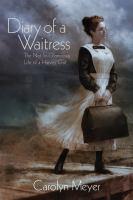
In the late 1800s and early-mid 1900s, the Harvey Girls were considered to be elite hostesses and servers for entrepreneur and businessman Fred Harvey. Harvey developed the concept of the ‘Harvey House’ dining areas along various railways across the United States, including the Atchison, Topeka, and the Santa Fe. These hospitality restaurants worked in tandem with the railways in order to provide first class service to passengers and railroad employees. Meals were served promptly on a strict schedule and all Harvey Girls were expected to follow a strict code of conduct that included a spotless uniform at all times, a strict curfew, and firm rules on fraternizing with patrons and railroad workers. All Harvey Girls were subject to contracts that could be canceled at any time by their supervisor and there would be a penalty for contracts that were not completed.
The women known as ‘Harvey Girls’ were able to travel across the country and explore uncharted territories. For many of the workers, this was their chance to leave home after finishing high school, given that college was not always a guarantee (a situation that plagued Kitty Evans in Carolyn Meyer’s historical piece Diary of a Waitress: The Not-So Glamourous Life of a Harvey Girl. ) Kitty, an aspiring journalist with dreams bigger than the Kansas skies, takes her shot as a Harvey Girl in order to develop her investigative skills and see a world outside of her own backyard. Readers are able to track Kitty’s growing maturity through diary entries and letters back to her family in Leavenworth. Though she’s away from her family, Harvey employees band together (as coworkers often do) to form a family of their own with plenty of antics along the way. Meyer’s prose reads like a Dear America for a more adult set as the casual reader sees glances at Kitty’s inner thoughts, ambitions, and dreams. The ultimate payoff for Kitty (and the readers) is how her journalism dreams eventually come true.
For a more theatrical take on the Harvey experience, MGM produced one of their famous Technicolor musicals centered on the Harvey way of life, aptly called The Harvey Girls. Completed in grand MGM fashion, there’s plenty of elaborate (for the time period) sets, costumes, and show stopping numbers to cap off major scenes. Our heroine is Susan Bradley (the unconquerable Judy Garland), who after being let down by a romantic pen pal decides to join up as a Harvey Girl in Sandrock, Arizona rather than go back home. There’s plenty of love, adventure, and mayhem in the untamed Wild West when the Harvey Girls are pitted against the established saloon over territory rights. This musical film is dedicated to the real life Harvey Girls, and wouldn’t be a 1940s musical without the requisite happy ending for all.
For a factual glimpse of the Harvey way, The Harvey Girls: Opportunity Bound blends footage of a National Harvey Girls Symposium in 2004 with fascinating tidbits about life as Harvey Girl out West. Chronicling the highs, lows, and everything in-between this documentary serves as a homage to the more than 100,000 Harvey Girls, providing stellar service with a smile. Their main motto of feeding the people right while providing the atmosphere they needed, traveled across the United States and adapted with the times to be strategically located near highways and airports in the later years of Harvey Houses.
Harvey Houses thrived under the watchful eye of Fred Harvey Jr. until the company was purchased by Amfac Inc. in 1968. Though the original houses no longer exist, there are museums dedicated to their memory throughout the United States: Florence, KS; Leavenworth, KS; Belén, New Mexico.
